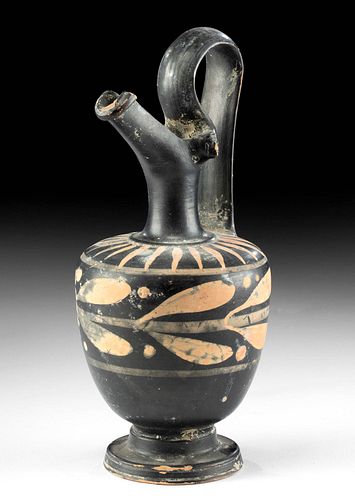Greek Apulian Xenon Prochous w/ Vegetal Motif
Lot 9
About Seller
Artemis Fine Arts
686 S Taylor Ave, Ste 106
Louisville, CO 80027
United States
Selling antiquities, ancient and ethnographic art online since 1993, Artemis Gallery specializes in Classical Antiquities (Egyptian, Greek, Roman, Near Eastern), Asian, Pre-Columbian, African / Tribal / Oceanographic art. Our extensive inventory includes pottery, stone, metal, wood, glass and textil...Read more
Categories
Estimate:
$1,400 - $2,000
Absentee vs Live bid
Two ways to bid:
- Leave a max absentee bid and the platform will bid on your behalf up to your maximum bid during the live auction.
- Bid live during the auction and your bids will be submitted real-time to the auctioneer.
Bid Increments
| Price | Bid Increment |
|---|---|
| $0 | $25 |
| $300 | $50 |
| $1,000 | $100 |
| $2,000 | $250 |
| $5,000 | $500 |
| $10,000 | $1,000 |
| $20,000 | $2,500 |
| $50,000 | $5,000 |
| $100,000 | $10,000 |
| $200,000 | $20,000 |
About Auction
By Artemis Fine Arts
Jun 24, 2021
Set Reminder
2021-06-24 10:00:00
2021-06-24 10:00:00
America/New_York
Bidsquare
Bidsquare : VARIETY SALE | Ancient & Ethnographic Art
https://www.bidsquare.com/auctions/artemis-gallery/variety-sale-ancient-ethnographic-art-7119
Featuring classical antiquities, ancient and ethnographic art. Egyptian, Greek, Roman, Etruscan, Near Eastern, Asian, Pre-Columbian, Native American, African / Tribal, Oceanic, Spanish Colonial, Russian, Fossils, Fine Art, more! All legally acquired, legal to sell. Satisfaction guaranteed. Artemis Fine Arts info@artemisfinearts.com
Featuring classical antiquities, ancient and ethnographic art. Egyptian, Greek, Roman, Etruscan, Near Eastern, Asian, Pre-Columbian, Native American, African / Tribal, Oceanic, Spanish Colonial, Russian, Fossils, Fine Art, more! All legally acquired, legal to sell. Satisfaction guaranteed. Artemis Fine Arts info@artemisfinearts.com
- Lot Description
Magna Graecia, South Italy, Apulia, Xenon, ca. 340 to 325 BCE. A classic prochous (prochoos) vessel - a petite cousin to the oinochoe - with an elegant inverted piriform body on a tiered foot, featuring twin applied faces (the visages wearing helmets or cap-like coiffures) to either side of the mouth and a characteristically dramatically upturned spout, created in a pottery workshop in the Apulia region of southern Italy where potters were known for introducing additional pigments to black glazed vessels and Greek settlers produced pottery inspired by Classical Greek forms. The surface of this example of Xenon ware presents two decorative registers adorning the body and shoulder - from top to bottom - a band of vertical frets and a register of elegant laurel leaves framed by thin linear bands - all in characteristic fugitive pink pigment. Overall, a lovely example that demonstrates skillful technique, an attractive painted decorative program, and a surface boasting stunning luster and areas of iridescence. Size: 3.25" in diameter x 6.9" H (8.3 cm x 17.5 cm)
A prochous is a vessel that some scholars believe was used for pouring water over the hands to cleanse prior to meals, while others suggest was used to pour and/or store oil and wine. Xenon ware is a specific type of Apulian pottery, named after a famous vase in Frankfurt (Beazley, EVP, p. 219,1.) that is inscribed with the name: XENON. This type is distinguished by added matte pink/red decoration over black glaze as we see in this example.
Provenance: private New York, USA collection; ex-private collection, acquired in the 1960s and imported to the United States in the late 1980s
All items legal to buy/sell under U.S. Statute covering cultural patrimony Code 2600, CHAPTER 14, and are guaranteed to be as described or your money back.
A Certificate of Authenticity will accompany all winning bids.
We ship worldwide and handle all shipping in-house for your convenience.
#164975Chip to base. Repair and restoration to spout, handle, and base. Some light nicks and scratches, commensurate with age. Otherwise, very nice with lovely earthen deposits.Condition
- Shipping Info
-
All shipping is handled in-house for your convenience. Your invoice from Artemis Gallery will include shipping calculation instructions. If in doubt, please inquire BEFORE bidding for estimated shipping costs for individual items.
-
- Buyer's Premium



 EUR
EUR CAD
CAD AUD
AUD GBP
GBP MXN
MXN HKD
HKD CNY
CNY MYR
MYR SEK
SEK SGD
SGD CHF
CHF THB
THB











